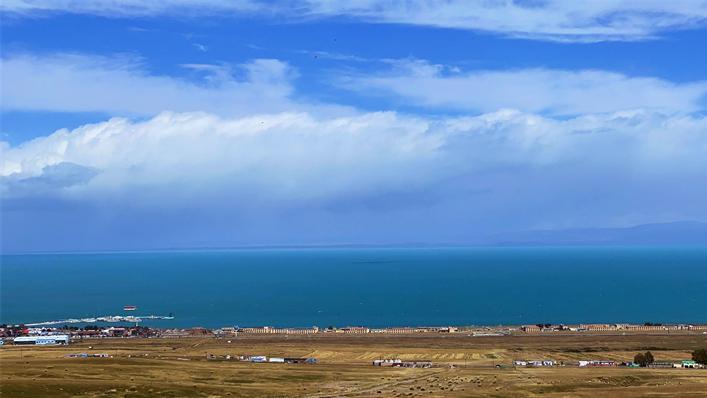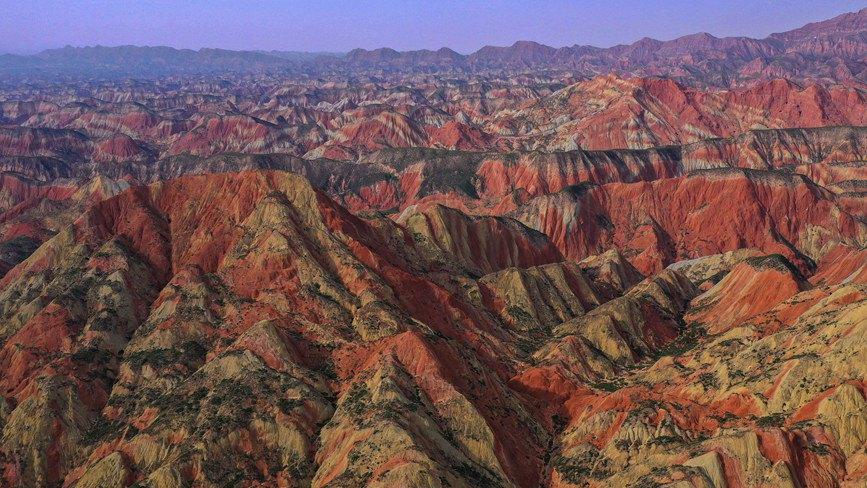Taoist temple exercise helps city workers relieve stress

(LU PING/CHINA DAILY)
Young white-collar workers in Beijing can easily find themselves frazzled by the pressure of their day-to-day jobs and the fast pace of city life.
A Taoist temple located in the Chinese capital's downtown Xicheng district, however, provides an oasis of serenity for young residents to relieve their aches and pains, ease their nerves, and find inner calm.
The courtyards of Baiyun Temple are shaded by towering trees and filled with the aroma of burning incense. Priests can be encountered everywhere at the temple — a living reminder of the historical significance of Taoism in China and its importance to believers.
An exercise known as baduanjin, a form of Taoist qigong that combines a set of eight traditional Chinese fitness movements with meditation and breathing, has been taught on weekends by priests for many years, attracting enthusiastic trainees.
Deng Jiayi, 30, is one of the instructors, and has been teaching baduanjin since 2017.
"We have found that the physical condition of people today is different from that of the past. Many people now are unable to learn martial arts or tai chi because their physical health is poor," Deng said. "Therefore, our master suggested using some health preservation exercises for the public to learn and improve, and baduanjin became the exercise offered as a public welfare class at the temple.
"Our master's wish is to promote our traditional Chinese culture, to let more people know about the profound culture so that they can benefit from it," said Deng.
The baduanjin exercise classes, held from 9:30 am to 11:00 am every Saturday and Sunday, offer two courses. They are taught by Taoist instructors who have studied martial arts from an early age at the country's most-sacred site of Taoism, Wudang Mountain in Hubei province.
Initially a set of qigong exercises practiced by Chinese folk groups, baduanjin has evolved since ancient times. Inferior elements of the exercise were discarded while the remaining ones were refined, leading to the practice of baduanjin in its current form.
Different schools and styles of martial arts, as well as qigong, have incorporated these techniques into their own systems, further boosting the spread of baduanjin.
Deng said the Sanfeng branch of Wudang baduanjin focuses on breathing and health preservation, while the Shaolin sect practices a more forceful and externalized style, which emphasizes muscle and internal strength.
Baiyun Temple teaches a style of exercise derived from the Huashan branch of the Taoist Quanzhen sect, with a focus on the regulation and flow of qi, a vital life energy, and blood.
Improving fitness
Over the past seven years, the baduanjin courses offered by Baiyun Temple have changed in their intensity, while interaction with the public has evolved.
Since the end of the COVID-19 pandemic, there's been a surge in young people interested in exercises to improve their health, Deng said. This increase has been achieved with the help of government support, he added.
However, some baduanjin novices struggle to complete even one round of training, he said. "During our classes, we noticed students experiencing dizziness, nausea, and difficulty standing up," Deng explained. "To prevent fainting or hypoglycemia, we provide huoxiangzhengqi water (a traditional herbal formula) and glucose."
Deng attributed the struggles of novice students to declining overall fitness levels and the teaching methods, which are challenging for newcomers. "We've since adjusted our approach to be less intense," he said.
Deng believes that many urban residents suffer from physical stress brought on by overthinking. But by practicing baduanjin they stretch and open up all their joints and limbs, and allow their entire bodies to slowly relax. This can calm their minds and provide them with a much-needed feeling of tranquillity, he said.
"During this practice, individuals can engage in self-reflection and gradually reduce stress, discomfort, and excessive mental anxiety," Deng said.
"The things that city residents bring about through social burdens, life, and work pressures, can be easily removed through our classes at the temple," Deng said, adding that trainees have been eager to learn and find solutions to relieve their stress.

Deng Jiayi (front) teaches baduanjin at Baiyun Temple in Beijing on Sept 21. (ZOU HONG/CHINA DAILY)
Life lessons
Jiang Tianxiao, a 22-year-old from the Guangxi Zhuang autonomous region, began practicing baduanjin in early August after realizing a feeling of unhappiness pervaded her life. Her first visit to Baiyun Temple was to burn incense and ask for blessings, but she also learned about the courses and the possibility they could improve her mental state.
Aspiring to work in the finance industry, Jiang graduated from university in June and started her first job in October.
In August, she spent every Saturday morning practicing baduanjin at the temple, and eventually her mood brightened.
"I had an internship that started in June. The salary covered my rent, but the job was not exactly what I wanted," Jiang said, adding she felt disappointed because she couldn't get involved with the core business of the company. "I guess I needed some psychological comfort back then," she said.
In July, a conflict she had with a longtime friend from high school upset her, and exacerbated her feeling of loneliness.
"My friend and I were both at the stage of just having graduated from college and entering internships. We faced the situation of renting an apartment, getting along with colleagues at work, as well as dealing with our own lives in the metropolis," said Jiang.
"She shared with me her discomfort during her internship and I gave her a piece of advice, which might have annoyed her because of my bluntness," she said, adding that small things increased the tension between them.
"I just felt during that period that I couldn't exhale completely," said Jiang. "It felt like I couldn't get a full breath out, and my breath got stuck when I inhaled."
Stretching while practicing baduanjin helped her. The teacher always emphasized trainees stretch as far as possible within their comfort zone.
"I've been enjoying the feeling of focusing on practicing at the temple, though it was a bit hard for me in the first stage," she said.
Baduanjin, which means "eight-section brocade" in English, is composed of eight individual movements. Jiang said the first three are the most difficult for her to practice, especially the second one.
"The second movement, called 'drawing the bow to shoot the hawk', involves opening your left and right arms while performing a martial arts squat. It requires balance and coordination to keep up with the rhythm taught by the teacher," she said.
"I'm struggling to coordinate the symmetrical movements, and it makes me feel a bit dizzy," she added.
Jiang created a document to record all the movements that the teacher at Baiyun Temple had taught her. "I sometimes practice at home, and it's pretty exhausting when I follow the teacher's instructions properly."
Steady progress
Zi You, who is a successor of Wudang Sanfeng martial arts and a baduanjin teacher, believes the younger generation has taken time and effort to come to the Baiyun Temple to learn, proving a strong willingness to practice the traditional exercise.
"Especially after the pandemic, there has been an obvious trend that more young people want to learn baduanjin, compared with seniors who previously made up the majority," he said. "The younger generation know their bodies need care, and want to get healthier."
Whenever students start a new workout routine, Zi suggests they begin slowly or with smaller movements, to ensure steady progress.
"For those who have been sedentary for long periods every day, year after year, it might be harmful to suddenly start intense activities like running or jumping," he said.
In such instances, practicing baduanjin can be a much healthier alternative.
"I often tell my students that you don't need to worry too much about the quantity of the practice in the beginning. Whenever you have a moment, like during your lunch break on workdays, and feel tension in your shoulders or neck, do a few repetitions," said Zi. "That can be a great starting point, and you will naturally want to keep going once you notice positive changes in your body and overall health."
Zi learned baduanjin as part of his martial arts training, which served as a relaxation technique during breaks from intense training.
"I'm still in the industry and I believe that if I can help one more person, if the students can understand and practice what I've taught them, and if it's beneficial to their health, I will be extremely happy," he said.

People attend the baduanjin exercise class at the temple on Sept 21. (ZOU HONG/CHINA DAILY)
Places of healing
Temples have played an important role in the capital city's public life since ancient times.
Susan Naquin, professor emerita of history and East Asian studies at Princeton University, highlighted this historical role in her book, Peking: Temples and City Life, 1400-1900.
Beijing's temples were the true center of public life in the city and hosted a wide range of activities including theatrical performances, markets, charitable relief, scholarly gatherings, festive pilgrimages, and book fairs, as well as art and leisure activities. All these public activities contributed to Beijing building a shared urban culture, and helped to form a "Beijing citizen" identity shared by people across the city.
Residents with different occupations in Beijing followed their own customs, rules, and habits in their daily lives. However, they shared a common need for psychological comfort. Religion, to a great extent, provided them with a place for spiritual solace, according to Naquin.
Deng, the teacher, said that young people in Beijing are under too much pressure from intense competition nowadays, and when their bodies can no longer cope, they develop various ailments.
"Whether they're going on a trip or just going out for fun, many of their tensions or discomfort may be alleviated," he said. "But once they return to their usual surroundings, they find themselves feeling tense again. It's like their old habits, even their walking pace and breathing, might quicken."
The temple provides a kind of retreat, a completely different environment, amid the pressures of living in Beijing.
"Only when a person becomes calm and composed can they truly handle their affairs. It's interesting how problems often seem insurmountable before they happen. But once they've passed, they often appear less significant. This is a natural part of the human experience," said Deng.
"By approaching all matters with a calm demeanor, we can reduce stress and anxiety. Because eventually, everything will pass."
Photos
Related Stories
Copyright © 2024 People's Daily Online. All Rights Reserved.









